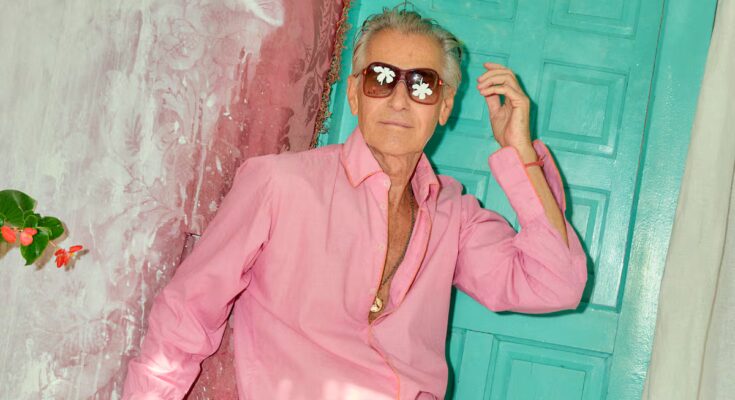The works of Grillo Demo (Rafaela, Santa Fe, Argentina, 69 years old) decorate the homes of the queens of pop and the palaces of European princesses. His paintings, collage and furniture design has pride of place in the living rooms of Madonna, Elton John, Kate Moss, Naomi Campbell, Elle Macpherson and Gloria von Thurn und Taxis. But Demo’s home-workshop, where he creates those pieces full of color and surrealism that the rich and famous love so much, is a humble two-bedroom house in Santa Eulalia, in the middle of the Ibizan countryside, hidden among bushes where roses, jasmine and bignonias grow.
“It’s a small house with a huge garden. It’s perfect for me. I have no neighbors around, just nature. I always say it’s like a suite in the countryside”, explains the artist in the center of his living room, a space he also uses as a studio. The demo has a Cecil Beaton vibe. “They often tell me I look like Peter O’Toole, but Beaton and Jean Cocteau are my idols, my virgins, my saints,” he says as he strikes a pose sofa beda mix between sofa and bed. The furniture is his work. He made the headboard with an old wooden bench from a sacristy.
In the early 2000s, his furniture designs for the famous English gallerist David Gill caused a sensation in London. In October 2002, Meredith Etherington-Smith, friend and collaborator of Princess Diana of Wales and director of Art reviewsaw his work and got it on the cover of the magazine. Martin Parr photographed Demo for the report. His furniture, paintings and collages became very popular among the British aristocracy. Above the sofa bed in the living room hangs a portrait of Lady Sybil Sassoon, one of England’s richest women in the 1920s and 1930s. The face of the famous countess is covered by a huge jasmine painted by the Argentine artist. It is a sketch commissioned by Lady Sybil’s nephew, David Rocksavage, Marquess of Cholmondeley.
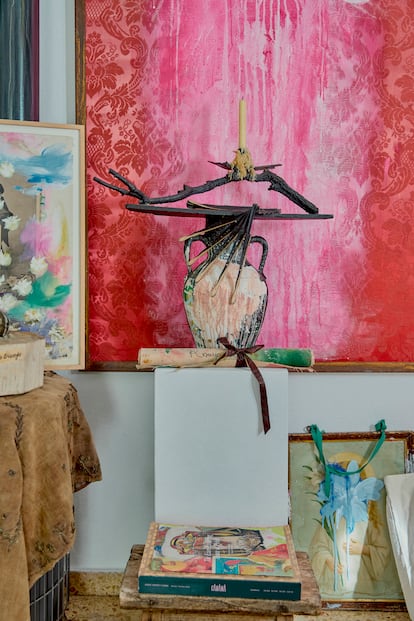
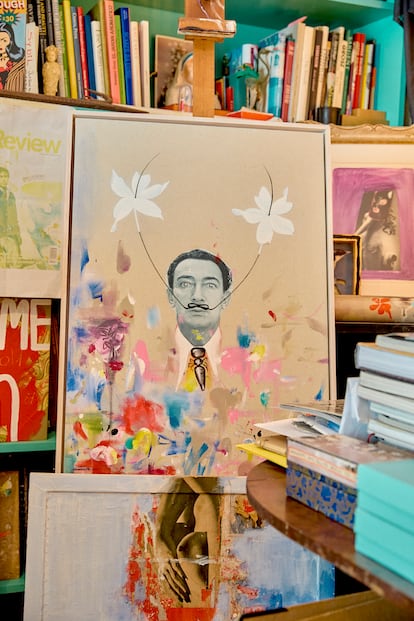
The portrait of the aristocrat is part of a successful series to which Grillo Demo has given his name Falling jasmine: very well-known, iconic faces, hidden behind a jasmine that acts as a mysterious veil. Many famous people visit the artist in Santa Eulalia to commission a portrait like that of Sassoon. “It’s been so long and they keep asking me,” he acknowledges. In one corner there is a sketch of the Falling jasmine which she did for French fashion editor Carine Roitfeld. In the guest bedroom are sketches of the portraits he made of Naomi Campbell and Kate Moss. There are his works everywhere: dreamlike paintings, altars with candles and flowers and decorations in the shape of lobsters, the crustaceans that obsessed Salvador Dalí.
“You may have noticed that my house is full of things. I don’t throw anything away. I accumulate like Jackie Kennedy’s cousins did in Gray Gardens, but my Diogenes syndrome is controlled, tidy and clean”, he clarifies. “My friends call this house Villa Favorita because it is full of art and because they have fun here.” The name is a tribute to the palace that the Thyssens had in Lugano. Heini and Carmen Thyssen stored their enormous collection of paintings there and received the cream of the cultural world. Demo has nothing to envy the barons, at least when it comes to friendships. Artists like Julian Schnabel and Anish Kapoor visit it. “People come to visit me. I try not to go out much. Where can I be better than here?”
Grillo, whose real name is Victor Hugo, arrived in Ibiza in 1978. He had just left his architecture studies in Argentina when he landed on the island with the dream of becoming an artist and leading a bohemian life. “It was winter, it was cold and it was dawn. From the sea I could see the smoke from the chimneys of the peasant houses and the almond trees in bloom. The island was full of hippies,” he recalls. “All this has already disappeared. In Ibiza there are almost no almond trees in bloom. There aren’t even any hippies, they’re all dead.”
THE socialite The Frenchwoman Nicole d’Almeida, one of Brigitte Bardot’s best friends, and the Irish gardener Sandy Pratt discovered the beauty of Santa Eulalia and the Ibiza countryside. “They showed me this area and I never left. I’ve worked and lived in New York and London, but my home has always been here.” He currently lives six months a year at Villa Favorita, from mid-May to mid-November. When the northern winter arrives, he moves to a small house on the beaches of Punta del Este, Uruguay, where he spends the southern summer.

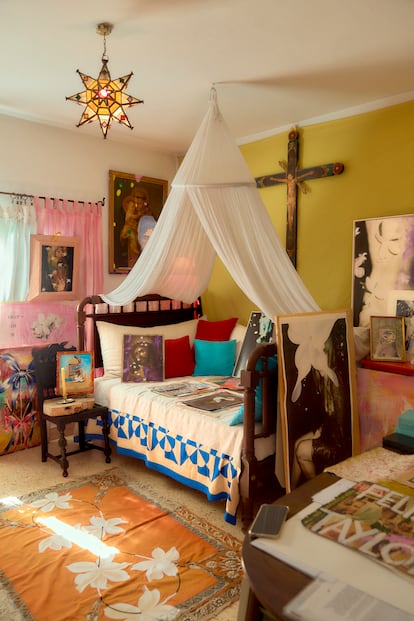
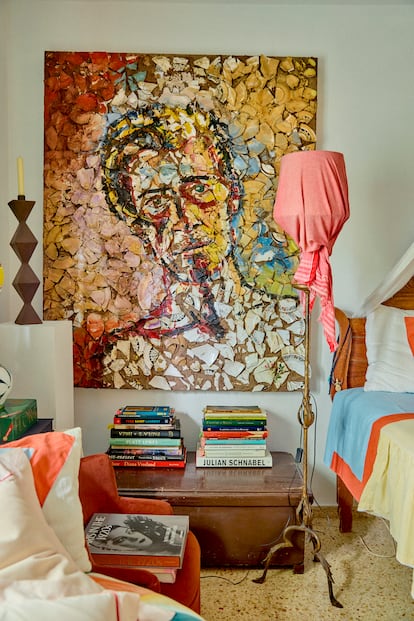
“I like to follow the sun. I live in an eternal summer. I live as if I were Barbara Hutton, the rich heiress, but I am neither rich nor an heir”, he clarifies. Hutton had a miserable life, Demo didn’t. “All lives can be sad, but with money it’s easier. As Françoise Sagan said: ‘Money doesn’t buy happiness, but I’d rather cry in my Jaguar than on the subway.’
He doesn’t like to talk about his famous friends and clients. The works in his house speak for themselves. In his bedroom, next to his 18th-century canopied country bed, hangs a portrait of himself signed by his friend Julian Schnabel. In the bathroom there is another portrait that Schnabel made of him next to a work by Sergio De Loof. A few centimeters from the tub there are original photos of Mario Testino, Peter Lindbergh and Damien Hirst, gifts from the artists. In the guest room she keeps her travel diaries and mementos: letters from Gilbert & George and portraits that the legendary fashion photographer Francesco Scavullo took of her in Key West in the 1990s.
It was around this time, in the 1990s, that Demo became famous in New York. Ingrid Sischy, editor of the magazine Interviewfell in love with his watercolors in the style of those made by Alexandre Serebriakoff in the mid-20th century. Sischy entrusted him with a titanic commission for the publication founded by Warhol: to immortalize the studies of the great artists of the New York scene of that time. Grillo painted in watercolor the workshops of Louise Bourgeois, Jeff Koons, Francesco Clemente, George Condo, Philip Taaffe and Kiki Smith, among others.
“After that I started getting jobs everywhere,” he recalls. Gallerist David Gill saw his interior watercolors and suggested he turn them into reality. Thus he began designing furniture and ceramics and limited editions of paintings. The cover of Art review and then the Madonna came. The singer saw a series of demos entitled in Gill’s gallery Baby Candy – Baby Jesus, black and white, dotted with technicolor jasmine – and he took three. “After that everyone ran out to buy a Childbecause you already know what people are like.

Since then everyone believes that he is close to the queen of pop. Vanity Fair She even called him “Madonna’s son.” “She bought my work, but I don’t know her. If I meet her one day, it will happen,” he says. He is elusive to success. Run away from him. At the height of his fame in London, he returned to his small house in Ibiza. “I want to be a stranger successful, like Princess Margaret (sister of the Queen of England). “I want to have all the privileges, but no obligations.”
He likes living in Santa Eulalia. In the morning he spends two or three hours taking care of the garden. Then he goes to the seaside and returns to Villa Favorita to paint. He always has several projects in hand. “The muses have to find you working, because if they find you dancing at Amnesia…” he says, referring to the Ibiza nightclub.
There’s a quote from Cecil Beaton that he really likes: “There is only one very good life, and that is the life you invent and build yourself.” He defines it very well. “I made myself up and invented this house. People who come to visit me always tell me, ‘This house is magical’. I’m happy that it looks that way, but someone has to make the magic happen.”

